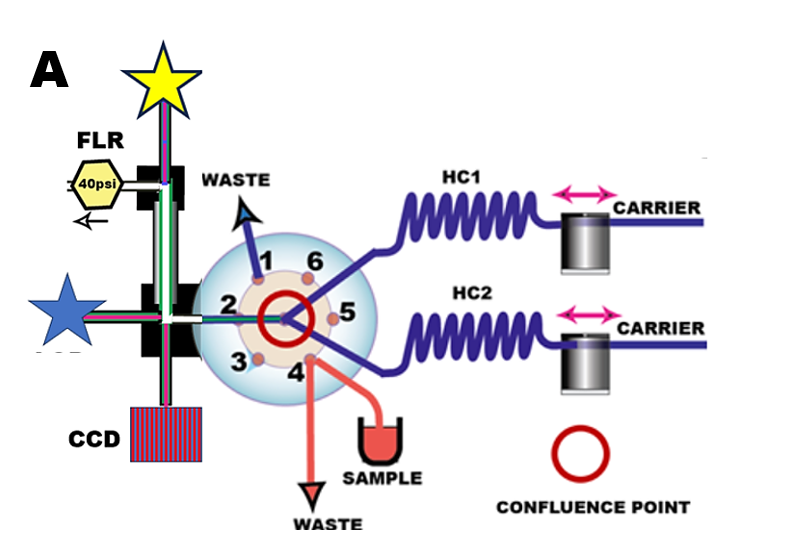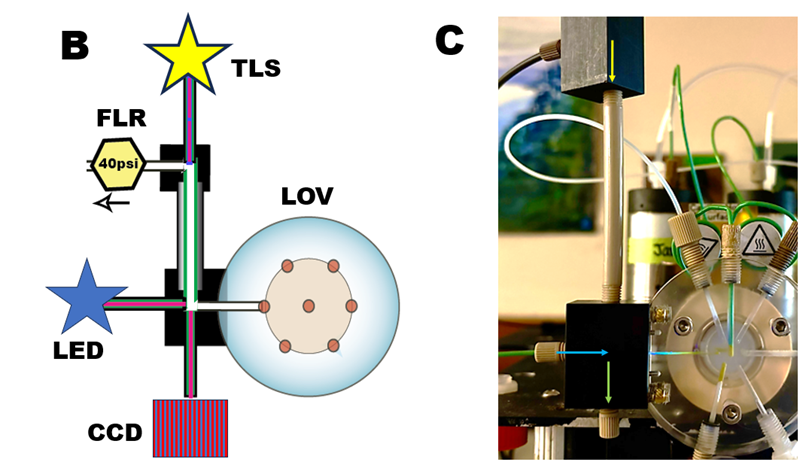3.2.7.1. Introduction
J. Ruzicka, M. Davis, M. Hatta and Ch. I. Measures © February 2024
Protocols of reagent-based assays are designed to meter and mix sample with reagent solutions in a defined way that will yield reproducible data obtained by monitoring of reaction product by spectrophotometry or by fluorescence. This is achieved by automation of assay protocol either by air Segmented Continuous Flow Analysis (CFA), or by Flow Injection Analysis (FIA). Since automation of spectrophotometry (or fluorescence) by CFA or FIA, must be tailored to provide optimized conditions of specific reagent-based assay, the toolbox of an analytical laboratory comprises a variety of single purpose analyzers, designed to accommodate single or multiple reagent assays and to perform either fluorescence or absorbance monitoring. Since these instruments are made by several vendors and often modified in house, their inventory, maintenance, and use are bewildering tasks.
Therefore, we introduce in this chapter, for the first time, the multipurpose instrument and show how it accommodates either single reagent based aluminum assay with fluorescence monitoring or two reagents based silica assay with absorbance monitoring, without instrument reconfiguration, since assay protocols are adjusted by software and maintained by computer control.
The multipurpose analyzer, based on the concept of programmable FI comprises following key components:
- Lab-on-valve microfluidics
- Multipurpose optical flow cell, furnished with light sources
- CCD array spectrophotometer

The platform for programmable FI system is the LOV manifold (A), connected upstream via holding coils (H1, H2) with milliGAT pumps. Details of this construct and performance are in Section 3.2.6.

The multipurpose flow cell (B) attached to LOV is connected by optical fibers to CCD spectrometer and two light sources. The tungsten light source TLS is switched on for spectrophotometry while the blue Light Emitting Diode LED is used for fluorescence spectrometry. The flow restrictor is used to elevate pressure within the flow cell to prevent formation of microbubbles by outgassing of the carrier. The multipurpose flow cell is a hybrid of Long Light Path (LLP) flow cell described in Section 3.2.3. and of orthogonal fluorescence flow cell described in Section 2.3.9.A Details of construction of LLP cell are in Guest contribution.
CCD Spectrometer (Ocean Optics USB 4000-F year 2013) is designed to support fluorescence, as well as absorbance measurements. However, it is widely recognized that sensitivity of fluorescence measurement by PMT is about 1000x higher than by CCD. Therefore at the outset of this project, preliminary experiments were performed with a fluorescent dye (fluorescein) to identify parameters that will maximize the output of CCD to match sensitivity of PMT. The results, summarized in Appendix, confirm that sensitivity of CCD based instrument is equal to PMT instrument when monitoring concentration of a dye. However, to confirm feasibility of multipurpose concept, performance of reagent-based determinations based on fluorescence and on absorbance measurements, must be compared with methods carried out with existing single purpose instruments. Therefore, determinations of aluminum by lumigallion and of silica by molybdenum blue performed on multipurpose platform are presented next.